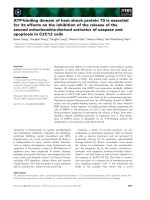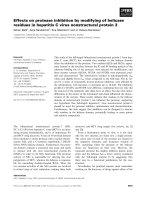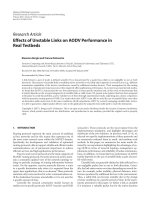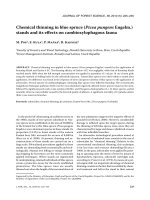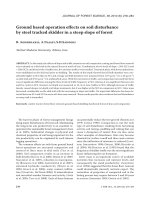Speaker age effects on prosodic patterns in bulgarian
Bạn đang xem bản rút gọn của tài liệu. Xem và tải ngay bản đầy đủ của tài liệu tại đây (1.47 MB, 5 trang )
9th International Conference on Speech Prosody 2018
13-16 June 2018, Poznań, Poland
Speaker Age Effects on Prosodic Patterns in Bulgarian
Snezhina Dimitrova1, Bistra Andreeva2, Christoph Gabriel3, Jonas Grünke3
1
Sofia University “St. Kliment Ohridski”, Bulgaria
2
Universität des Saarlandes, Germany
3
Johannes Gutenberg University Mainz, Germany
, , ,
known and widely-investigated prosodic manifestations of
adult speaker age in the speech signal include speech rate
(segment and syllable duration, number of segments per unit
of time, number and duration of pauses), sound pressure level,
F0 (mean, level, range and standard deviation), spectral tilt,
etc. ([1], [3], [5], [9], [10]).
However, the correlation between perceptual and acoustic
cues to ageing is not always a straightforward one. Besides,
some perceptual cues used by listeners to determine a
speaker’s age seem not to correspond to any measurable
attributes of the acoustic signal. It is also important to note
that some of the results hitherto reported in the literature are
divergent or even occasionally contradictory.
A conspicuous feature which has not been previously
analyzed, probably due to the primary orientation of existing
research towards the technological or clinical domain, is the
pattern of F0 change. Although some of the above-mentioned
studies incorporated pitch curve information into the prosodic
components of their models (e.g., [3] and [5]), pitch contour
tracking was done automatically, and without any
consideration of the linguistic importance of the respective
change in pitch.
We investigate prosodic variability in the speech of young
and mature speakers of Standard Bulgarian (SB) – a South
Slavic language for which no longitudinal or cross-sectional
research on age-related prosodic variability exists to date.
Unlike most of the studies cited above, we approach the
question of age-related variability in the speech signal
primarily from a socio-phonetic point of view, and focus our
attention in the present investigation on differences
attributable to age which are found in the prosodic (temporal
and intonational) domain.
Abstract
We investigated prosodic variability attributable to age in
Standard Bulgarian. In readings of The North Wind and the
Sun, recorded by two groups of six female speakers aged
between 19-23 and 79-88 years, we found significant
differences in pitch span, minimum F0, syllable, intonation
phrase and pause duration. The older speakers made more
pauses, which were also of longer duration. They also realized
longer syllables and intonation phrases than young speakers.
Both groups used the same inventory of pitch accents and
boundary tones, but there were significant differences in the
frequency counts of some of the tones: young speakers used
pre-nuclear rises with a post-tonic high target, while older
speakers preferred rises with a high target within the stressed
syllable; the nuclear pitch accent used most frequently by the
young speakers was L*, whereas the one preferred by the
elderly speakers was L+H*; younger speakers used more
phrase accents (especially H-), while older speakers preferred
boundary tones (H-% and L-%) and “level” (H-L% and HL-)
pitch curves. Our findings suggest that the study of tonal
repertoires and frequencies of use could offer interesting
insights into age-related differences between speakers.
Index Terms: age-related variation, intonation, phrasing,
pause duration, Bulgarian
1. Introduction
Age-related variation in speech has been studied extensively,
primarily for age estimation or for clinical application
purposes. Researchers have mainly used one of two
methodological approaches – acoustic analysis or perception
tests. A useful introduction along with a comprehensive stateof-the-art review of studies of the acoustic phonetic
manifestations of ageing in the sound signal, intended
primarily for the purpose of building reliable automatic
classifiers of speakers according to their age, is provided by
[1]. Other studies aiming at facilitating automatic age
estimation of speakers’ voices include [2], [3], [4] and [5], to
name but a few.
On the other hand, studies such as [6] and [7] approach the
question about the manifestations of ageing in the speech
signal from the point of view of clinical research. An
interesting further perspective on the relationship between
vocal characteristics and perceived age is offered by [8], who
investigated the possibility to affect age perception through
vocal manipulation.
Most of the above research has been interested in
identifying features of ageing both on the level of the sound
segment and on the supra-segmental level. Some of the well-
2. Empirical study
2.1. Speakers and data
Our data consist of readings of the Bulgarian version of
Aesop’s fable The North Wind and the Sun by two groups of
female speakers. The text was recorded by the speakers
together with materials for other experiments not reported
here. Two of the mature speaker recordings were made in
September 2012, whereas all remaining recordings were made
between September 2016 and May 2017.
The first group consists of six mature speakers of Standard
Bulgarian who were between 79 and 88 years old at the time
of recording (henceforth the “79-88 GROUP”). Two of them
have lived in Sofia all their lives, while the other four moved
to the Bulgarian capital city either in very early childhood, or
709
10.21437/SpeechProsody.2018-144
as young adolescents for study purposes. All mature female
speakers hold an academic degree.
The second group consists of six young females who were
aged between 19 and 23 at the time of recording (henceforth
the “19-23 GROUP”). They were all born, grew up and live in
Sofia. All of them were undergraduate university students.
The pronunciation of both groups of speakers displays the
features typical of the capital Sofia.
The long-term distributional (LTD) measures which
were calculated for the purposes of the present analysis were
as follows: for pitch level - mean and median F0 values (in
Hz), for span – pitch excursion (in semitones - ST), computed
as the difference between the maximum and minimum pitch
values obtained over a given IP. The measure used for
describing F0 distribution variation is the standard deviation
(SD, in Hz).
The obtained Hertz measurements for span were
additionally converted to semitones by means of the formula
in [13]:
39.863 * log10 (Maximum/Minimum).
(1)
A Praat script was then used to calculate the LTD
measures.
Finally, we used the ToBI labelling conventions outlined
in [14], and also employed in recent Autosegmental-Metrical
analyses of the intonation of the Sofia variety of Contemporay
Standard Bulgarian ([15], [16], [17]) to mark pre-nuclear and
nuclear pitch accents, phrase accents and boundary tones in
the data (for an example, see Tier 1 “accents” in Figure 1).
2.2. Methodology
The temporal characteristics which were investigated in the
present study were mean syllable duration, speech tempo
(number of syllables per second), intonation phrase (IP) and
pause duration.
Syllable boundaries were marked and prominent syllables
were labelled manually in Praat [11] (for an example, see
Figure 1). All temporal features were measured using Praat
scripts.
We also analyzed pitch level (defined as the overall height
of a speaker’s voice) and pitch span (defined as the range of
frequencies typically covered by a speaker). According to
[12], the two are partially related but nevertheless distinct
characteristics of a speaker’s performance to which F0 values
can be attributed.
Figure 1: The utterance “Северният вятър беше принуден да признае” (‘The North Wind was obliged to confess’), pronounced
as a single IP by a young female Bulgarian speaker. Labelling of the data: tier 1 – ToBI labelling of pitch accents, phrasal accents
and boundary tones; tier 2 – syllable boundaries and prominent syllable labels; tier 3 – speech intervals (x) and pauses (p); tier 4 –
Bulgarian text; tier 5 – English translation.
710
example, in the young speaker’s utterance shown in Figure 1,
all pre-nuclear pitch accents are of the L*+H type (with the H
target of the first one aligned two syllables after the accent).
On the other hand, in the mature speaker’s pronunciation of
the same utterance which is realized as two separate IPs, the
pre-nuclear pitch accent in the first IP is H*, and the two prenuclear pitch accents in the second IP are both of the L+H*
type.
2.3. Results and discussion
Linear mixed models (LMMs) with the respective measure as
dependent variable, Speaker as random factor, and Group (old
“79-88 GROUP”, young “19-23 GROUP”) as fixed factors
were calculated, and post-hoc tests were carried out.
2.3.1 Fundamental frequency
Statistically significant differences were found for pitch range
and minimum F0.
The minimum F0 value for the “79-88 group” was 135.8
Hz (St. error = 8.9), and 176.9 Hz (St. error = 8.9) for the “1923 group“, (F [1, 10.06] = 10.7550, p<0.01).
Pitch range for the “79-88” was 11.6 ST (St. error = 0.66),
whereas for the “19-23 group” it was 9.1 ST (St. error = 0.66),
(F [1, 9.119] = 6.9627, p < 0.01).
The wider pitch range used by the mature group of female
speakers does not corroborate many of the previously reported
findings in the literature which show the F0 range of older
speakers to be narrower than that of younger ones. However,
our present findings are in line with [18] who found a
statistically significant main effect for age on minimum F0,
span in Hertz and semitones, and SD: their “older” group
Bulgarian speakers showed a significantly lower minimum F0,
higher F0 span in Hertz and semitones, and higher SD than the
“younger” Bulgarian speakers who participated in their study.
Besides, results obtained e.g. for Hungarian by [19] found an
insignificant effect of age on F0 range, emphasizing the fact
that the pitch domain used by a speaker is very much an
individual characteristic.
The lower F0 used by the mature speakers, on the other
hand, is generally in conformity with findings for other
languages (see overview in [19]).
The two groups of speakers use roughly the same number
of pitch accents and boundary tones (Table 1).
Figure 2. The utterance “Северният вятър беше принуден
да признае” (‘the North Wind was obliged to confess’),
pronounced as two IPs by a mature female Bulgarian speaker.
If phonetic alignment details are disregarded, it appears that
younger speakers use rising pre-nuclear tones with a low pitch
target associated with the stressed syllable and a high pitch
target reached in the post-tonic syllable (L*+
4.3% of the time). On the other hand, the “79-88 GROUP” use
pre-nuclear rises in which the H target is associated with the
stressed syllable (L+
The distribution of pre-nuclear pitch accents is shown in
Table 2.
Table 1: Number of pre-nuclear pitch accents (PAs),
nuclear pitch accents and phrase and boundary tones
used by the two groups of speakers
19-23 GROUP
79-88 GROUP
pre-nuclear
nuclear
Boundaries
250
257
142
159
146
163
Table 2: Pre-nuclear pitch accent repertoires used by the two
groups of speakers (in %).
Our analysis of the types of accents shows that the speakers
use very similar tonal repertoires. For frequency counts of the
different pitch accents realized by the two groups, we used Chi
square tests, the results of which showed statistically
significant differences between the groups.
19-23
79-88
H* H+L* L* L*+
45.9 1.6 5.4
1.6
L*+H L+
21.2
9.6
2.7
11.7
31.1
Nuclear pitch accents
Chi square tests for frequency counts of the different nuclear
pitch accents realized by the two groups again showed
statistically significant differences between the groups:
χ2 (5, N = 301) = 25,533, p <.001.
Both groups use H* nuclear pitch accents (31.5% - by the
“79-88 GROUP” vs. 26.8% by the “19-23 GROUP”).
However, the most frequent tone which was used half of the
time by the “19-23 GROUP” is actually L* (50%, vs. 25.2%
for the “79-88 GROUP”). On the other hand, the older
speakers use L+H* 33.3% of the time, while in the readings of
the younger speakers it is found only 14.1% of the time. For
example, the nuclear pitch accent used by the young speaker
Pre-nuclear pitch accents
Frequency counts of the different pre-nuclear pitch accents
used by the two groups of speakers were statistically
significant:
χ2 (6, N = 507) = 62,537, p <.001.
Both groups of speakers use pre-nuclear H* pitch accents
(45.9% and 43.2% of all pre-nuclear accents realized by the
“79-88” and “19-23” groups, respectively). But while for the
“79-88 GROUP”, L+H* is the second most frequently used
tone which is found 31.1% of the time, the “19-23 GROUP”
prefers to use L+
711
in Figure 1 is L*, while the two nuclear pitch accents used by
the mature speaker in Figure 2 are both L+H*.
The distribution of nuclear pitch accents is shown in Table
3, below.
Table 5. Number of pauses and intonation phrases (IPs),
means and SDs (in ms) used by the two groups of speakers.
19-23
79-88
Table 3. Nuclear pitch accent repertoires used by the two
groups of speakers (in %).
H* H+L* L* L*+H
L+
50.0 1.4
1.4
14.1
79-88 31.5 6.9
25.2 0.6
2.5
33.3
PAUSES
N Mean
SD
68 434.75 246.24
116 434.46
243.46
IPs
N
Mean
SD
140 1180.51 517.46
150 1471.86 777.98
Finally, mean syllable duration differences were also
statistically significant: mature speakers from the “79-88
GROUP” used longer syllables (M = 183.07 ms, SD = 20.09)
than younger speakers from the “19-13 GROUP” (M = 137.04
ms, SD = 6.06), (F [1, 10] = 28.8565, p < 0.001).
Boundary tones
Chi square tests for frequency counts of the boundary tones
realized by the two groups of female speakers again showed
statistically significant differences between the groups: for
boundary tones, χ2 (8, N = 309) = 50,291, p <.001.
Both groups of speakers use a low phrase accent followed
by a low boundary tone L-% about 29% of the time. It is the
most frequent boundary marker in the readings of the “79-88
GROUP”, followed by H-% (21.5%). For the younger group,
however, the most frequently occurring tone is H- (36.3%,
usually preceded by a L* nuclear pitch accent).
Generally, in our data younger speakers tend to use more
phrase accents (especially H-), while mature speakers seem to
prefer boundary tones (H-%, L-%) and “level” (H-L%, HL-)
pitch curves.
The distribution of boundary tones is shown in Table 4.
3. Conclusions
Our analyses of the temporal characteristics which distinguish
younger from mature speech in our corpus are mostly in line
with findings reported previously in the research literature for
other languages. Our group of older female speakers made
almost twice as many pauses as the young group, and the
pauses were of longer duration compared to pauses made by
the young speakers. The “79-88 GROUP” also realized
intonation phrases which were on average 300 ms longer, and
syllables which were on average 46 ms longer than those
realized by the “19-23 GROUP” of young female speakers.
As far as the F0 characteristics which we analysed are
concerned, our results are not in full conformity with
published findings. Contrary to many previous studies, we
found that the elderly speakers who took part in our
investigation used a wider pitch range than the younger
speakers. This finding, however, seems to corroborate doubts
about the universal nature of F0 changes as cues to ageing
([9], [19].
Perhaps the most interesting of our findings concerns the
distribution and use of pitch accent and boundary tone types.
Although both groups made use of the same inventory of
tones, they differed significantly in the frequency counts of
some of the tones. Young speakers used pre-nuclear rises with
a post-tonic high target (L*+
rises with a high target reached within the stressed syllable
(L+
frequently by the young speakers was L*, whereas the one
which was used most frequently by the elderly speakers was
L+H*. Generally, in our data younger speakers tended to use
more phrase accents, while mature speakers seemed to prefer
boundary tones and “level” (H-L% and HL-) pitch curves.
To our knowledge, no comparable data on tonal use by
young vs. elderly speakers has been hitherto reported in the
literature. The statistically significant results that we obtained
seem to suggest that this line of research could offer
interesting insights into the age-related differences between
speakers.
Table 4. Boundary tones used by the two groups of speakers
(in %).
H- H-% HL- H-L% L- L-% LH- L-H%
19-23 36.3 9.6
6.9 6.9
2.7 28.8 2.0 4.1
79-88 7.4 21.5 11.0 17.2
0.6 29.5 1.8 8.6
We are unaware of similar research comparing the tonal
inventories and frequency counts of the types of tones used by
young and elderly speakers. The statistically significant results
that we obtained seem to suggest that this line of research
could offer interesting insights into the pitch pattern
preferences of different age groups of speakers.
2.3.2 Temporal characteristics
The “79-88 GROUP” made almost twice as many pauses as
the “19-23 GROUP” of speakers (116 vs. 68 pauses,
respectively). The average duration of the pauses and the
standard deviation for the two groups, however, was almost
identical (M = 434.46 ms, SD = 243.46 for the elder group,
and M = 434.75 ms, SD = 246.24 for the younger group).
However, mean intonation phrase (IP) duration for the two
groups was shown to be statistically significant: 150 IPs, M =
1471.86 ms , SD = 777.98 for the “79-88 GROUP” vs. 140
IPs, M = 1180.51 ms, SD = 517.46 for the “19-23 GROUP”;
(F [1, 10.53] = 6.3802, p < 0.05) (Table 5).
712
4. References
[1]
[2]
[3]
[4]
[5]
[6]
[7]
[8]
[9]
[10]
[11]
[12]
[13]
[14]
[15]
[16]
[17]
[18]
[19]
S. Schötz, “Acoustic Analysis of Adult Speaker Age,” in C.
Müller (ed), Speaker classification I. Lecture notes in computer
science (vol. 1). Berlin: Springer, pp. 88–107, 2007.
W. Spiegl, G. Stemmer, E. Lasarcyk, V. Kolhatkar, A. Cassidy,
B. Potard, S. Shutn, Y. Song, P. Xu, P. Beyerlein, J.
Harnsberger, E. Nöth, “Analyzing features for automatic age
estimation on cross-sectional data,” in Proceedings of Interspeech 2009, Brighton, United Kingdom, pp. 2923–2926, 2009.
J. Volín, T. Tykalová, T. Bořil, “Stability of prosodic
characteristics across age and gender groups,” in Proceedings of
Interspeech 2017, Stockholm, Sweden, pp. 3902–3906, 2017.
C. Müller, “Automatic recognition of speakers’ age and gender
on the basis of empirical studies,” in Proceedings of Interspeech
2006, Pittsburgh, PA, 2006.
M. Li, K. J. Han, S. Narayanan, “Automatic speaker age and
gender recognition using acoustic and prosodic level information
fusion,” Computer Speech and Language vol. 27, pp. 151–167,
2013.
L. D. Shriberg, R. Paul, J. L. McSweeney, A. Klin, D. J. Cohen,
F. R. Volkmar, “Speech and Prosody Characteristics of
Adolescents and Adults With High-Functioning Autism and
Asperger Syndrome,” Journal of Speech Language and Hearing
Research vol. 44, pp. 1097–1115, 2001.
D. R. Barnes, “Age-related changes to the production of
linguistic prosody,” Open Access Theses, Paper 17, 2013.
S. S. Waller and M. Eriksson, “Vocal age disguise: the role of
fundamental frequency and speech rate and its perceived effects.
Front. Psychol. 7, article 1814, pp. 1–10, 2016.
S. E. Linville, “The sound of senescence,” Journal of Voice vol.
10, pp. 190–200, 1996.
J. D. Harnsberger, R. Shrivastav, W. S. Brown, Jr., H. Rothman,
H. Hollien, “Speaking rate and fundamental frequency as speech
cues to perceived age”, Journal of Voice vol. 22, pp. 58–69,
2008.
P. Boersma, D. Weenink, Praat: doing phonetics by computer
[Computer program]. Version 6.0.36, retrieved 11 November
2017 from />D. R. Ladd, Intonational phonology, Cambridge: Cambridge
University Press, 1996.
H. Reetz, Artikulatorische und akustische Phonetik, Wissenschaftlicher Verlag, Trier, 1999.
K. Silverman, M. Beckman, J. Pitrelli, M. Ostendorf, C.
Wightman, P. Price, J. Pierrehumbert, J. Hirschberg, “ToBI: A
standard for labelling English prosody,” Proceedings of the
Second International Conference on Spoken Language
Processing (ICSLP 92), Banff, Alberta, 1992, pp. 867–870,
1992.
B. Andreeva, Zur Phonetik und Phonologie der Intonation in der
Sofioter Varietät des Bulgarischen, PhD dissertation,
Saarbrücken: Universität des Saarlandes, 2007.
B. Andreeva, W. J. Barry, J. Koreman, “Local and global cues in
the prosodic realization of broad and narrow focus in
Bulgarian,” in M. Zygis, Z. Malisz (eds), Slavic perspectives on
Prosody (Special issue of Phonetica vol. 73, 2016, pp. 256–
278), 2017.
S. Dimitrova, S.-A. Jun, “Pitch accent variability in focus
production and perception in Bulgarian declaratives,” in
Proceedings of the 18th International Congress of Phonetic
Sciences, Glasgow, United Kingdom, 2015, Paper number 0832,
retrieved from />icphs-proceedings/ICPhS2015/Papers/ICPHS0832.pdf
G. Demenko, B. Möbius, and B. Andreeva, “Analysis of pitch
profiles in Germanic and Slavic languages,” Forum Acusticum
2014, 7–12 September, Kraków, Poland, 2014.
A. Markó, J. Bóna. “Fundamental frequency patterns: The
factors of age and speech type,” in Proceedings of the Workshop
“Sociophonetics, at the crossroads of speech variation,
processing and communication”, Pisa, 14–15 December 2010,
pp. 45–48, 2010.
713

